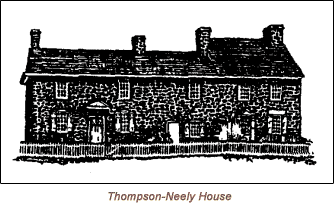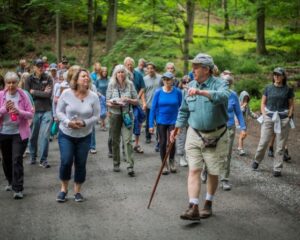Washington Crossing Park became a National Historic Landmark in 1961. It is comprised of land and buildings in both Upper Makefield and Solebury townships. The Solebury section is along River Road between Aquetong Road and Bowman’s Tower (the tower is actually in Upper Makefield Township).
Thompson-Neely House
 This nationally recognized structure located on River Road across from Bowman’s Hill Wildflower Preserve is a fine example of 18th century architecture. During the winter of 1776-77 this home was used to care for Washington’s troops who were healing from wounds or suffering from diseases and camp illnesses. In addition, Bridgade Commander William Alexander (known to contemporaries as Lord Stirling) lived in the house in December 1776. On Stirling’s staff were William Augustus Washington and James Monroe (later to become the fifth president of the United States), both of whom were wounded in the Battle of Trenton and said to have convalesced at the Thompson-Neely House.
This nationally recognized structure located on River Road across from Bowman’s Hill Wildflower Preserve is a fine example of 18th century architecture. During the winter of 1776-77 this home was used to care for Washington’s troops who were healing from wounds or suffering from diseases and camp illnesses. In addition, Bridgade Commander William Alexander (known to contemporaries as Lord Stirling) lived in the house in December 1776. On Stirling’s staff were William Augustus Washington and James Monroe (later to become the fifth president of the United States), both of whom were wounded in the Battle of Trenton and said to have convalesced at the Thompson-Neely House.
The house was built in three sections, the center being the earliest. Under the heading of “history evolves,” the continuing architectural research of this important building is uncovering new scenarios. During a Society-sponsored walk and tour of the house, we learned that the earliest structure may have been a one-story log dwelling built by settlers in the early 1700s. This differs from a prior assumption that the early section was built of stone. John Pidcock was an early settler on a 400-acre tract of land which included the parcel upon which the Thompson-Neely house stands, and some believe it was he who built the early cabin.
The central portion of the house was built by John Simpson, a Quaker mill owner in c.1740. Upon his death, his Scotch-Irish Presbyterian miller, Robert Thompson, married Simpson’s widow and claimed ownership of the property. Thompson added the west side of the house in 1757 as well as a second floor extension over the central portion. Thompson founded the Presbyterian Church on Aquetong Road, now known as the Thompson Memorial Presbyterian Church. The east side of the house was completed in 1788 for Thompson’s daughter and her husband, William Neely, as a separate dwelling. Hence the name “Thompson-Neely House.”
In close proximity to the house stands a barn and various outbuildings, restored examples of structures that would have completed an 18th century farm complex. Across the road from the house is a restored, water-powered mill built along the Pidcock Creek in the 1830s by the Neely family. The original mill, constructed nearly a century earlier by Robert Thompson, was located approximately 100 yards downstream from the present mill. Thompson’s milling business was quite successful, reflecting the important role of the miller in the agricultural society of colonial Pennsylvania when the grinding of grain was a basic function to sustain life. He supplied a thriving market in Philadelphia and was listed as one of the township’s wealthiest men in the late 1700s. During the Revolution, it is likely that the mill provided grain for troops camped on the Thompson land and surrounding properties in December 1776.
Washington Crossing Park also includes a group of historic buildings in Washington Crossing, Upper Makefield Township, along River Road near Route 532.
The Soldier’s Graves area is accessible via the Pennsylvania Delaware Canal State Park towpath in Solebury Township.
Washington Crossing Park hours and tour availability change frequently. Consult the website of the Pennsylvania Historic and Museum Commission for more information.
View an interactive map of the locations of nationally recognized properties and districts in Solebury Township.


